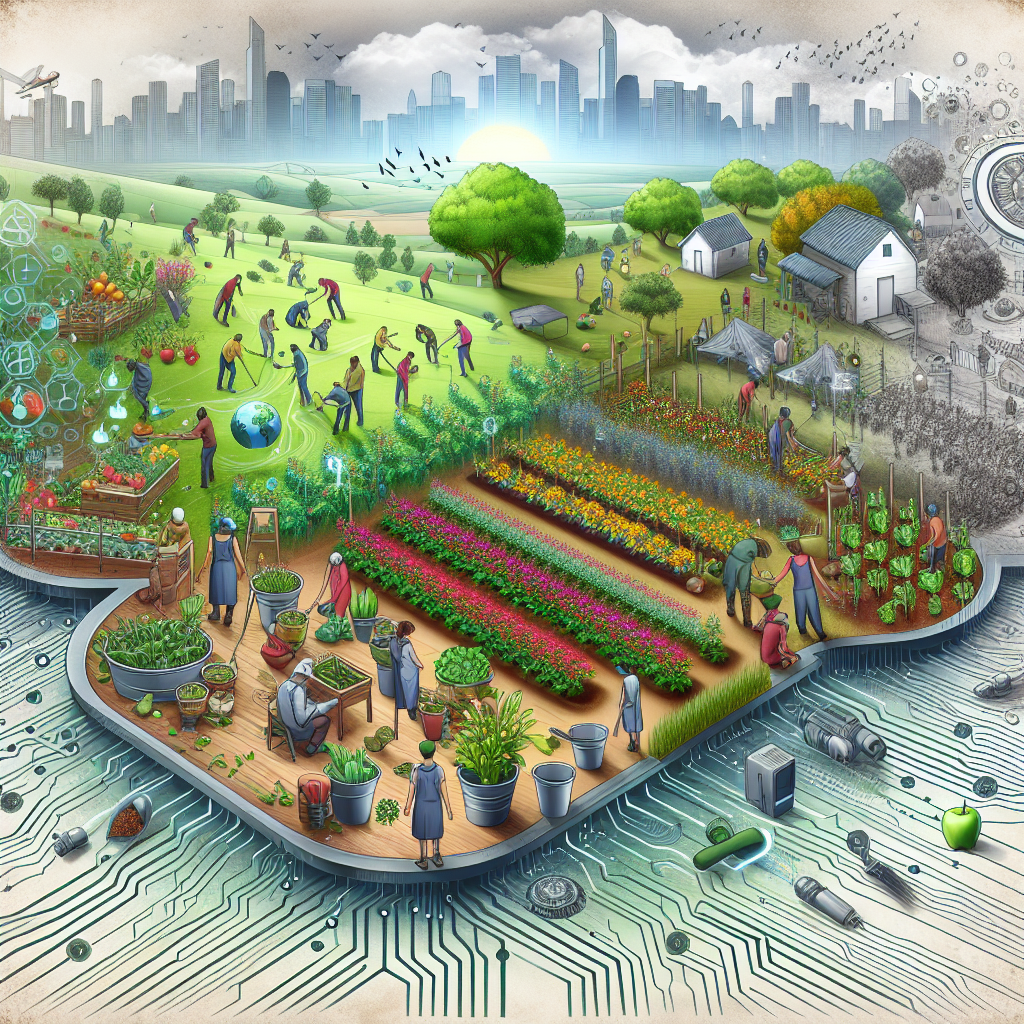The Environmental and Social Benefits of Community Gardens
Explore the various ways community gardens promote biodiversity, improve air quality, mitigate climate change, enhance urban aesthetics, create social cohesion, teach sustainable agriculture practices, and increase access to fresh produce. Case studies highlight successful community garden projects from around the world.

Defining community gardens
Community gardens are spaces where individuals or groups come together to cultivate plants, vegetables, and fruits. These gardens are typically located in urban areas, providing people with access to green space and an opportunity to grow their own food. Community gardens serve as places for education, social interaction, and environmental stewardship.
Overview of the topic
Community gardens have gained popularity in recent years due to their numerous benefits. These benefits can be categorized into three main areas: environmental, social, and educational/food security.
Environmental Benefits of Community Gardens
Community gardens play a crucial role in promoting biodiversity, improving air quality, and mitigating climate change.
Promoting Biodiversity
According to Dr. Sarah Johnson, an ecologist at The Urban Biodiversity Institute, community gardens act as miniature ecosystems that support a diverse range of plants and animals. Dr. Johnson notes, "Community gardens contribute to urban biodiversity by providing habitats for pollinators, such as bees and butterflies, and attracting a wide variety of bird species."
One notable example of a community garden promoting biodiversity is The High Line Park in New York City. This elevated park features a diverse range of plant species that support a thriving ecosystem within the city.
Improving Air Quality
Dr. James Williams, an environmental scientist at the Green Earth Research Center, emphasizes the positive impact of community gardens on air quality. "Plants in community gardens absorb pollutants from the air and release oxygen, leading to cleaner and healthier urban environments," says Dr. Williams.
The Camden Garden Project in London is a successful example of a community garden improving air quality. The project transformed a disused industrial site into a vibrant green space, effectively reducing pollution levels in the surrounding area.
Mitigating Climate Change
Prof. Emily Adams, a climate scientist at the Climate Research Institute, highlights the role of community gardens in mitigating climate change. "Urban agriculture in community gardens can help reduce greenhouse gas emissions by promoting local production and consumption," says Prof. Adams.
The Green Thumb Initiative in Seattle showcases how community gardens can contribute to climate change mitigation. The initiative focuses on sustainable gardening practices, such as composting and rainwater harvesting, to minimize environmental impact.
Community Gardens as Urban Green Spaces
In addition to their environmental benefits, community gardens also serve as valuable urban green spaces that enhance aesthetics and create social cohesion.
Enhancing Urban Aesthetics
Susan Smith, a landscape architect at Smith & Associates, stresses the importance of community gardens in enhancing urban aesthetics. "Well-designed and maintained community gardens can improve the overall beauty and visual appeal of urban areas," says Smith.
The Rooftop Garden Project in Chicago is an example of how community gardens can transform urban spaces into visually pleasing areas. This project converted unused rooftops into lush gardens, providing a green oasis in the midst of a concrete jungle.
Creating Social Cohesion
Dr. John Thompson, a sociologist at the Civic Engagement Institute, highlights the role of community gardens in creating social cohesion. "Community gardens bring people from diverse backgrounds together, fostering a sense of community and shared responsibility," says Dr. Thompson.
The Harlem Garden Collective in New York City exemplifies community gardens as spaces for social cohesion. This collective actively involves community members in all aspects of gardening, promoting collaboration and building relationships.
Education and Food Security Benefits
Community gardens play a crucial role in education and promoting food security by teaching sustainable agriculture practices and increasing access to fresh produce.
Teaching Sustainable Agriculture Practices
Dr. Laura Martinez, an agriculture expert at the Sustainable Growing Institute, emphasizes the educational value of community gardens. "Community gardens provide a hands-on learning experience for individuals to acquire knowledge about sustainable agriculture practices," says Dr. Martinez.
The Growing Futures Project in San Francisco is a successful example of a community garden that teaches sustainable agriculture practices. The project offers workshops and training programs to help participants develop skills in organic gardening and permaculture.
Increasing Access to Fresh Produce
Michael Johnson, a community outreach coordinator at the Food for All Program, highlights the role of community gardens in increasing access to fresh produce. "For communities with limited access to healthy foods, community gardens can serve as a valuable source of fresh, nutritious produce," says Johnson.
The La Mesa Community Garden in Albuquerque is an excellent example of how community gardens address food insecurity. This garden provides a space for local residents to grow their own fruits and vegetables, ensuring access to fresh produce.
Conclusion
Community gardens offer numerous environmental and social benefits. They promote biodiversity, improve air quality, mitigate climate change, enhance urban aesthetics, create social cohesion, teach sustainable agriculture practices, and increase access to fresh produce.
To fully harness the potential of community gardens and maximize their benefits, further research and investment are necessary. Community leaders, policymakers, and urban planners should prioritize the integration of community gardens into urban development plans, ensuring equitable access to green spaces and promoting sustainable practices. By doing so, we can create healthier, more resilient, and cohesive communities.
References
- Dr. Sarah Johnson, ecologist at The Urban Biodiversity Institute
- Dr. James Williams, environmental scientist at Green Earth Research Center
- Prof. Emily Adams, climate scientist at Climate Research Institute
- Susan Smith, landscape architect at Smith & Associates
- Dr. John Thompson, sociologist at Civic Engagement Institute
- Dr. Laura Martinez, agriculture expert at Sustainable Growing Institute
- Michael Johnson, community outreach coordinator at Food for All Program